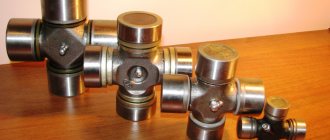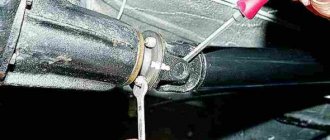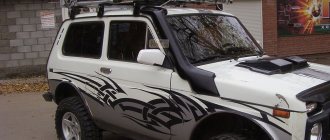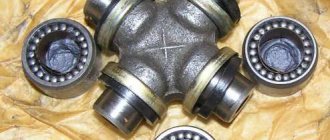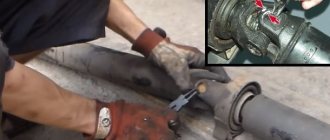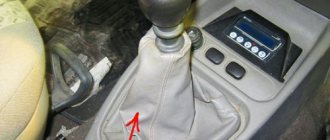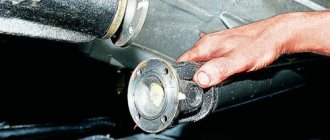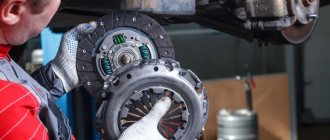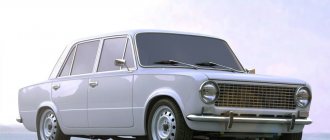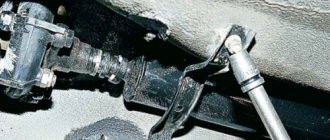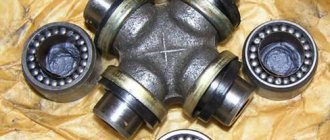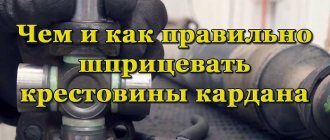When the time comes for a planned replacement of the cardan crosspiece or (more likely) vibration, beating, noise and crackling begin in the area of the cardan, car owners are prepared to pay a significant amount for repairing the cardan. Most often the cardan crosspiece requires replacement. This part cannot be restored, it can only be replaced. It is not expensive, but replacement work will require removing the cardan, so be prepared to spend a whole day at the service station. If you are not afraid of difficulties, then you can change the cardan cross with your own hands.
The cardan serves to connect the gearbox and the rear (in a rear-wheel drive car) or front (in all-wheel drive) axle. Its task is to transmit rotation from the engine to the bridge or bridges. The connection point for these elements is the hinge, the main part of which is the cross. It has the shape of a cross, at the ends of which there are cups with needle bearings. The bearing is separated from the housing by a sealing ring made of rubber or plastic. For each car model, the dimensions of the crosspieces differ from each other.
When to replace the rear propeller shaft spider
Important!
Rear driveshaft crosspieces are important parts of the driveshaft. It is necessary to install high-quality and good parts, because this determines how effectively the rotation from the engine will be transmitted, as well as safety while driving. If you hear a knock, noise, or feel vibration while the vehicle is moving or when changing gears, you need to check the universal joint and may need replacement. It is worth noting that the rear crosspiece deteriorates faster. It has a large load. But such signs can indicate not only the breakdown of these parts, therefore, before making a replacement, it is necessary to perform diagnostics.
Determining the cause of extraneous noise
To determine the problem, you need to know where the driveshaft spider is located and how to access it. This will require an inspection ditch or a lifting mechanism, since the part can only be inspected from below.
Inspection stages:
- We turn on neutral gear.
- Let's look at the cardan. Be sure to pay attention to the technical condition of the seals.
- We check for play. We hold the crosspiece and begin to rotate the cardan. If play is detected, the part will have to be removed. If you only hear an unpleasant sound, you may only need to replace the lubricant.
- We examine the second cross.
Most often, the rear universal joint spider fails. It takes on increased load and works in more difficult conditions.
Diagnostics
The machine is placed on a pit or a lift. The transmission is set to neutral. The mechanism is inspected under the car. You need to carefully examine the seals of the crosspieces. It is necessary to fix this part and begin to rotate the cardan. If there is no gap and there are extraneous sounds during rotation, only the lubricant is replaced. You may not have to change the crosspiece itself. There are two of these parts in the mechanism. It's worth checking every cross. Particular attention is paid to the rear part; more dirt and water fall on it during movement.
What could be wrong:
- Part backlash.
- The needle bearing is worn out.
- The part itself has become unusable.
- Lubricant leak.
- Damage to the O-ring.
- Extraneous sounds while driving.
Signs of malfunction of VAZ 2107 crosspieces
Malfunctions of crosspieces are usually associated with wear of the sealing collars and dirt getting inside the bearings, which, having abrasive properties, begins to destroy the metal. This manifests itself as follows.
- at a speed of about 90 km/h, characteristic impacts from below are felt;
- when the reverse gear is engaged, vibration appears;
- When the driveshaft swings from side to side, play is detected.
It is much easier to identify a faulty crosspiece on a removed cardan. If the bearings are damaged, the hinge will rotate poorly in one of the planes, and sounds resembling crunching or rustling will appear.
Clicking noise when starting
The first sign of a faulty universal joint is a loud clicking sound when turning on first gear at the start of movement. When such sounds, reminiscent of a clinking pan, appear, it is recommended to rotate the parts of the cardan in different directions with your hands, while holding the hinges. If large play is detected, the crosspieces must be replaced. It is noteworthy that sometimes clicks can appear only during a sharp start from a standstill, and when the movement begins smoothly, they may not appear.
Vibration
Often, if the crosspieces are faulty, vibration occurs when reversing. Sometimes it does not disappear even after replacing the crosspieces, but begins to appear at average speed. Moreover, the vibration may become even stronger than before replacing the CC. Such situations are a consequence of non-compliance with the alignment of the cardan elements during its assembly.
Sometimes vibration persists even after work has been done correctly. The reason for this is usually the use of low-quality products when replacing CC. Experts advise tapping the cups on all sides with a metal tube before installing new crosses. This will allow the stuck circlips to move and the vibration will go away.
Factors of breakdowns
Each shaft part is subject to breakage and wear. And the rear driveshaft crosspiece is no exception. Let's look at the main causes of failure:
- The part has completely worked itself out - this is a natural factor.
- Neglect of scheduled technical inspection. Since the parts of the mechanism are constantly rotating, they need to be lubricated, and in the absence of scheduled maintenance, lubricants are not applied. And this reduces the life of the cross.
- Saving and DIY repairs. This part is unique for each car. When replacement is necessary, owners think about how to save money and do the repairs themselves, as well as buy parts cheaper. All this increases the clearance and changes the torque transmission angle.
Important! The lifespan of the part is reduced to literally 20 days, which leads to repeated replacement.
- Don't forget about the quality of the roads. The cardan cross is always loaded, the outboard bearing reduces the load, but the poor road surface creates vibration conditions. She is not compensated for anything. The load on the part increases, resulting in rapid wear.
- The most important thing is the quality of the part. The crosspiece may be defective, which is why it will also quickly become obsolete.
Who in the world is the boss of crosspieces?
The undisputed industry leader is GKN (Guest, Keen and Nettlefolds). This is one of the oldest companies in Europe, founded in 1902. Today the GKN Group owns 40 factories, which are located in 30 countries around the world and are located based on their territorial proximity to car manufacturers. GKN produces 60 million joints annually, and GKN universal joints, spiders and CV joints account for 40% of the global driveshaft market. Crosspieces and CV joints produced by the concern are known on the domestic market under the Lobro brand. On the European aftermarket for spare parts, the concern offers drive shafts, CV joints and other auto parts under the Spidan brand.
GKN's scientific programs successfully solve the current problems of cardan joints. Thus, since November 2009, maintenance intervals for all GKN Walterscheid driveshafts have been significantly increased, on average for various models about 200 operating hours, and this is a significant reduction in maintenance costs. The achievement was a consequence of the use of improved crosspieces and the use of hardened shaped pipes. The lubricant used in Lobro hinge joints is lifelong and does not require maintenance.
Long-term operation without maintenance associated with the need to re-lubricate the joint, replace cups or retaining rings is also guaranteed by another manufacturer - the Swedish company SKF, the largest manufacturer of bearings in the world. SKF has 80 factories in 22 countries. The company employs 39,000 people. The total annual turnover of all divisions of the company is about 3.5 billion US dollars.
GMB is also one of the largest manufacturers of spare parts. In addition to the head office and factories in Japan, the company has representative offices in England, Germany, and factories in the USA, Korea, and India. GMB crosspieces offer an optimal price-quality ratio. In addition to automobile assembly lines and the secondary market, spare parts from GMB are purchased by Japanese Jtekt, Koyo Machine Industries, Kyowa Kogyo, KS Sanoyas Co., Yamada Manufacturing, Central Automotive, TMY Corporation, European GKN Group, Dana Group, Neapco, Weasler, Clark, Delphi and other auto component manufacturers. Toyo Seiko Co., Ltd is Japan's largest manufacturer of aftermarket spiders. Founded in 1982, the company produces about 180 thousand units per month. The company's crosspieces are sold all over the world. The largest sales volumes are in the Middle East, Australia, South America, and South Asia. Toyo products have been sold on the Russian market for many years and during this time they have proven themselves to be very reliable and durable.
The plant for the production of bearings and cardan shafts FKL Temerin, part of the Serbian company FKL, is well known in Europe, South America, even in Africa. The company began operations in 1961, and over the course of 49 years it has developed a wide range of products. FKL crosspieces of excellent quality are successfully used on Mercedes, Iveco, Volvo vehicles. The Turkish company Tirsan Kardan has proven itself well in our market. The quality of the products is high, the prices are reasonable. Currently, crosspieces are widely used by the GAZ Group in the new GAZelle Business.
Replacing the cross
Before replacement, the cardan is removed. But before you disassemble, you need to consider a number of points:
- To make it easier to unscrew the nuts, they must be lubricated with WD-40.
- Mark the cardan flange and rear axle with a chisel to prevent vibration.
- To maintain the thread, use a curved spanner.
- When turning the bolts, they are fixed with a screwdriver.
It all starts with unscrewing the four pins on the mechanism. The suspension bearing mount is removed. Then the cardan. It comes out of the gearbox spline connection. This fragment is wrapped in cloth to prevent sand from entering.
Next, you will need the following tools: a hammer, pliers, a wide screwdriver and a tube of the appropriate caliber. The mechanism is clamped with a vice. The crosspieces are removed with special devices. Then the retaining rings are removed. Then the cup is knocked out of the eyes. Use a hammer and a spacer. We prepare the parts and install the cross.
Important! To improve the quality of the repair, it is necessary to clean the eye and fork from dirt and remove rust.
To do this, use a brush with metal bristles and sandpaper. The surfaces inside should also be treated and lubricated before installation. Use an awl or a thin screwdriver to clean the rings. We separate the crosspiece from the cups and install it between the eyes. When removing the bowls, you should carefully monitor the needles so that they do not fall apart. After which they are returned to the cross and heated until the locking grooves open. Finally the rings are replaced.
Cardan joint: device, purpose
The device with two forks is made in the form of a universal joint, which performs the main function in the gearbox. It is divided according to the type of transmitted rotation:
- transmitting rotation of equal angular velocities (CV joint);
- transmitting rotation of unequal angular velocities;
- with a semi-cardan elastic and rigid hinge.
Mechanisms are single-shaft, double-shaft and multi-shaft; based on the number of hinges, they can be divided into single-, double- and multi-hinge.
In front-wheel drive cars, CV joints are installed that do not use crosspieces.
The mechanism is mounted on vehicles with rear-wheel drive or all-wheel drive. When transmitting unequal angular velocities, one and sometimes two cardans are used, it all depends on the distance over which the rotation needs to be transmitted.
The first shaft, located from the gearbox to the support, is called the intermediate shaft, and the second is called the rear shaft. They are connected using a support, rigidly fixed with a clamp on the bottom of the car. This is the so-called suspension bearing.
This device is designed to properly maintain HF. This design uses an additional hinge with a cross. In addition to this gearbox, a compensating device is used, which is called a sliding clutch. It is designed to lengthen or shorten the cardan while the machine is moving and is a splined connection between the cardan and the fork tip. When overcoming obstacles, a mutual change occurs between the rear axle and the car body. As a result, the cardan is compressed or stretched. These changes are compensated by a sliding clutch. If it is necessary to transmit rotation to two shafts at an angle, a mechanism with a semi-elastic hinge is used.
Installing the cardan
Before carrying out this procedure, you need to know the following:
- It is good to lubricate each connection.
- There should be no dirt on moving parts.
- Checking the seals.
- It is necessary to make sure that our marks coincide, otherwise we will have to carry out balancing.
The first step is to install the splined part, after tightening the four bolts, attach the outboard bearing. The bolts must be tightened tightly.
In some cases, repairs are not carried out. It will be enough to inject. This requires a large syringe and lubricant. During this process, you should pay attention to the rear crosspiece. After all, she is most susceptible to dirt. Some crosses have gaps for this procedure. This must be done until the lubricant begins to flow out.
Malfunctions
Gearbox failure is characterized by strange sounds; while driving, the car moves jerkily, and a metallic sound is heard when changing gears.
The main gearbox malfunctions are:
- play in the hinges;
- deformation of the cardan shaft. This malfunction occurs when struck by a stone or when hitting a protruding obstacle;
- damage to the seals or their deterioration;
- damage to protective covers;
- wear of needle bearings;
- weakening of mechanism connections.
All defects that arise can be easily eliminated by car service specialists. Faulty elements are replaced with new ones, and loose connections are tightened.
If the crosspiece is faulty, the most correct solution would be to transport the car on a tow truck to a car service center, where they will diagnose the car using special stands, identify the faulty part and offer the best repair option. Important! Some owners try to carry out diagnostics in car services located in garage cooperatives. As a rule, there is no staff there, and one specialist is not able to know all the intricacies of repairs.
Therefore, car enthusiasts should not contact such car services. Apparent savings on repairs turn into additional, and often not small, costs. When performing work, our car service uses methods developed at manufacturing plants. After any repair work, the car owner receives a warranty for spare parts and all types of services and repairs.
Checking work
It can be done after the installation of the mechanism in the machine is completed. It is checked in the same way as when detecting play. In addition, the mechanism is examined for oil and grease leaks. The seals are also carefully inspected. In addition, they check on the road.
Pay attention to the presence or absence of extraneous sounds and the sensation of vibration. It is worth mentioning that you cannot carry out these procedures yourself. You can violate the angle of rotation, which will lead to wear of the part and its next replacement. It is better to turn to qualified specialists, pay money and enjoy the quality work of the craftsmen.
Recommendations for use
Important! In order to extend the service life of the device, you should check the condition of the protective covers when undergoing maintenance at a car service center. At the slightest damage, replace them with new ones, thus protecting the bearings from dirt, which prevents their premature failure. Driving methods also affect the longevity of the system.
Slipping when driving off-road, sudden acceleration, prolonged driving on deep snow or a dirt road with a high rut.
Crosspieces with movable guard rails.
The main difference between crosses and a movable guardrail (Fig. 3) and conventional crosspieces is the presence of a movable guardrail, instead of one of the fixed guardrails, and a spring to return it to its place after the wheels pass along its groove. Supporting bridges are essential for crosspieces with a movable guard, and a carriage is often part of the structure in addition to the double pads. Various details, such as anti-lift devices and a retaining shoe, are intended to keep the guard in place in relation to the costal parts of the cross. Recently, crosspieces with spring guards have begun to attract more attention. Recent projects have eliminated many wasteful parts and now produce a cross that is more powerful and requires less maintenance. AREA has developed designs for 1/9, 1/10, 1/11 and 1/12 grade crosspieces. These designs have short spring rails and replace all the rivets in the reinforcing strips with bolts. In addition, clamping brackets attached to the main bolts and bolted to the carriage or pads replaced the former rivet connections. The carriages provide the crosspiece with the correct direction in profile and plan, and rivet joints, on the contrary, give unsteadiness and play due to corrosion or vibration under the composition. Although these new designs require greater articulation at the joint due to the short spring length of the rail, they have been used successfully on busy roads for several years. The short guard at the front of the cross allows the use of a shorter counter rail in a straight path, and this is its advantage. Crosspieces with a movable guardrail are used almost exclusively on main lines - at transfers and exits, where traffic occurs primarily along the main track. Properly designed shock absorbers ensure that the spring rail remains open as the train passes and closes with a slight click after the last wheel of the train has passed, without damaging the crosspiece.
Rice. 3. Crosspiece with a movable guardrail: 1 — length of the crosspiece; Lpp - front part; Lnm is the theoretical length of the front part; Lxn - tail section; L xm - theoretical length of the tail section; 1 — front liner; 2 - movable guardrail; 3 - fixed guardrail; 4 — guards for legs; 5—carriage; 6 — main liner; 7 — place of insertion of the short core rail; 8 — core liner; 9— theoretical tip; 10 - practical tip; 11 — guide bracket; 12 — spring cup; 13 — fuse for legs; 14— tail liner; 15 - long core rail; 16 — corner of the cross; 17 - short core rail; 18 — paired linings; 19 — front liner; 20 - fixed rail; 21— straight butt plate; 22 — movable guardrail; 23 - stepped bolt; 24 — curved butt plate; 25 — external spiral spring; 26 — internal spiral spring; 27 — rod; 28 — rod guide bushing; 29 — recess in the rail head; 30— spring cup bracket; 31— spring cup; 32 — movable guardrail; 33 - amplification band; 34- guide bracket; 35 — guide bracket bracket; 36 — cushion of the guide bracket; 37 — support for the bolt head; 38 — clamping bracket; 39 — main liner; 40— core liner
The guardrail spring rail is sharply bent to provide sufficient space for the guardrail spring rail to be able to open when the wheels of the train pass. A triangular recess is cut into the head of the spring guardrail to allow the flanges of the wheels of the train passing along the main track to pass through. The notch is 12.7 mm deep at the tip and disappears at the point of the core where the bandage completely covers both rails. This prevents impacts from worn flanges and unnecessary opening of the spring guard during the passage of rolling stock.
